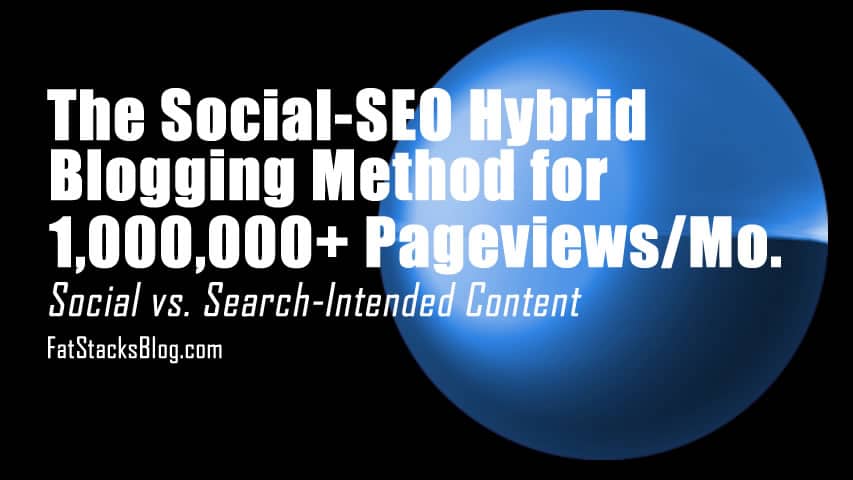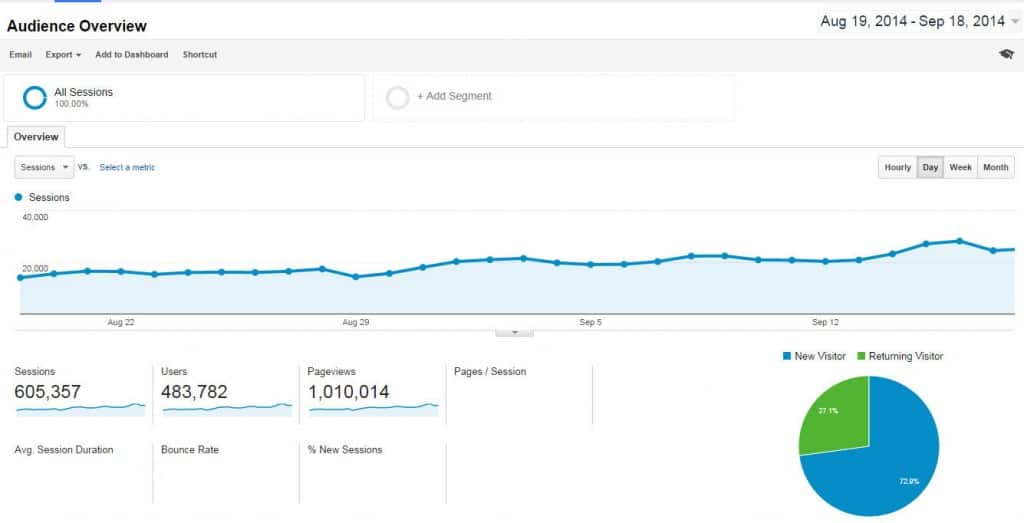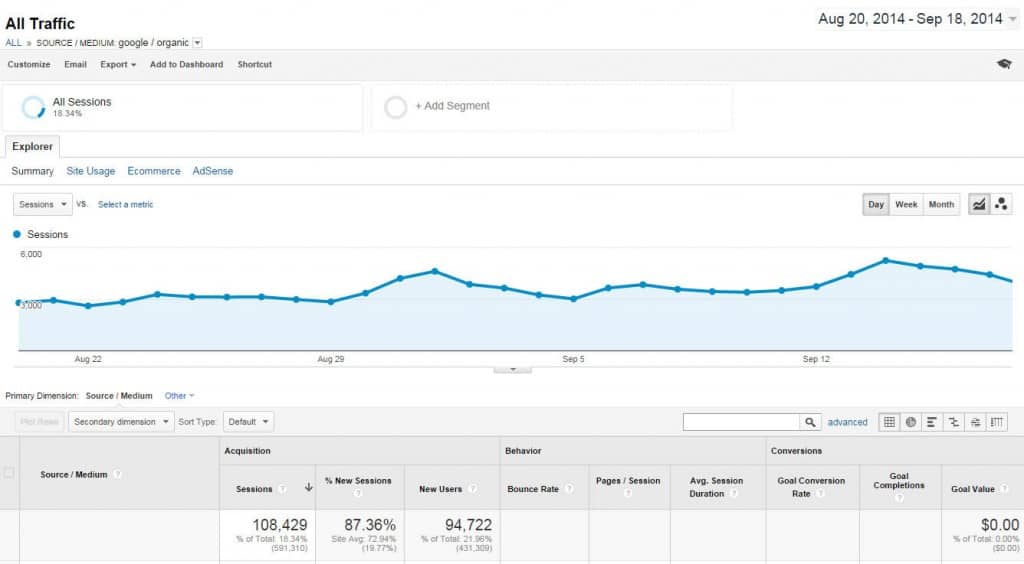Social vs. Search Intended Content

In a nutshell, my main blogging method is what I call the Social-SEO Hybrid Method.
I guess it’s a way to describe a blog or website that aims for both piles of social media and organic search traffic.
I’m certainly not the only website publisher doing this. Most popular sites go for both types of traffic.
The reason I’m publishing a post on the hybrid method is to get you thinking about embracing BOTH social media and SEO traffic. Many bloggers and internet marketers choose one or the other. I suggest you do both… which is what I’m doing and it works very, very well.
For example, there are the hardcore SEO cadre of internet marketers who crank up websites and focus on getting organic search traffic to their web pages. Social media isn’t part of the equation.
On the flip side, there are site publishers who only focus on social media traffic creating viral style content over and over and over paying no attention to keyword research and getting traffic from the search engines.
The thing is, SEO and social media are not mutually exclusive. In fact, they work very well together. However, you still need to wear the two hats separately.
Traffic Screenshots (for 1 niche blog)
1. All traffic for 30 days

2. Organic Search Traffic (for the same 30 days)
As you can see, organic search traffic is about 1/9 of overall traffic. However, revenue is approximately 1/7 of overall revenue.
It’s rare that content performs well both socially and for organic search. After all, social content success requires great copy which often excludes (not always, but often) keyword-focused headlines and meta info. I do give one example at the bottom of this post of a type of content that works well on social media and attracts long-tail commercial organic search traffic.
That’s not to say social-focused content won’t get organic search traffic; instead the traffic isn’t going to be all that valuable and likely not all that plentiful. The reason viral traffic is valuable is not because of search traffic but because of the piles of social media traffic it generates.
Watch the Video for all the Details
1. Monetization:
Social: primarily monetized with display ads.
Search traffic: primarily monetized with affiliate promotions.
2. Traffic duration:
Social: short-term, but immediate and plentiful. An exception to short-term is if you run paid social advertising campaigns (which I do).
Search traffic: Slow, but long term.
3. Value (Revenue Per Thousand Page Views – RPM):
Social: Lower RPM, but volume makes up the difference.
Search: Higher RPM, but less traffic.
To put this into perspective, based on one of my niche blogs:
- Total monthly revenue: $30,000 to $45,000 net profit per month (it fluctuates month-to-month – see income reports).
- SEO Revenue: Approximately $6,000
While SEO-derived revenue is a small percentage of overall revenue, I continue investing a fair amount into organic search traffic because it’s a long term revenue strategy. Organic search traffic revenue has no ongoing costs associated with it (I don’t use private blog networks and don’t buy links) which means the ROI and long term growth potential is very good.
More importantly: organic search traffic revenue is more valuable. Organic search traffic comprises about 1/9 of all traffic, yet generates a consistent 1/7 (approximately) of revenue.
4. Content type:
Social: Pretty much no limitations. Short, long, text, media, embedded videos… the sky is the limit. It just needs to be enticing and content that people like to share. Read more about one content strategy I use with great success here.
Search: Needs attention to on-site SEO such as keyword usage, word count (to a certain extent), media… the more the merrier to create great content.
Note: Just because social content has less restrictions doesn’t mean it’s easier or faster to create. Coming up with great content that people share is not easy. Often it involves a great deal of work (just as publishing great content for organic search traffic).
5. Promotion:
Social: Very easy – just post to social media channels. This takes only a few minutes.
Search: Depending on the intended keywords, promotion can be extensive. Posting to social media is just the start (yes, you can certainly post organic-search intended content to social media channels). You may need to hustle for backlinks using any variety of methods available.
6. Buying traffic:
Social: For very successful posts, I promote those posts with Facebook ads and native advertising.
Search traffic: Bing ads for paid traffic, which I monitor very closely to ensure it results in a positive ROI.
7. Quantity (Publishing Demands):
Social: Heavy demand on content quantity… must crank out new content all the time to keep the social traffic spigot turned on.
Search: Doesn’t require as much content. Instead, must work on ranking existing content. It’s better to have one top-ranked valuable piece of content than 10 pieces of content sitting on page 3 of Google search for intended keywords.
8. Content concept
Social: Largely entertains. This is a generalization, but the viral stuff is usually entertaining at a fundamental level or is breaking news.
Search: Mostly informs and educates. Most of the search-oriented content I publish is designed to presell something, which requires informing or educating.
How do I implement the Social-SEO Hybrid Model?
I have a pretty simple system.
Each day, my aim is to publish 1 piece of content intended for social media traffic and 1 piece of content intended for long term organic search traffic. It’s a demanding schedule, but once the content concepts are planned out, it’s just a matter of putting it together. It gets easier once you have a nice inventory of content scheduled into the future.
Some of my extremely commercial-oriented organic search content, I publish as pages to keep it out of the blog feed. Examples of this would be product reviews (I write product reviews in batches after buying and testing 10 to 12 products in a particular product line).
What are the advantages of operating a Social-SEO Hybrid Blog?
I didn’t plan on a social-SEO hybrid blog. It just kind of happened.
My initial aim was to focus on social media traffic. However, despite my total lack of SEO efforts (i.e. no keyword research), my site started getting quite a bit of organic search traffic by month 3 (500 visits per day).
Having an SEO background, that got me pretty excited. I’ve never been an SEO expert, but I’ve done okay with it over the years. I became excited because I realized I had a high-traffic website that was gaining authority quickly with which I could leverage for more organic search traffic.
That’s when I planned and started the SEO content generation. I figured why rely solely on social media traffic when with a little planning and effort I could attract plenty of high-value organic search traffic.
The result: I went from 500 organic search visits per day to 4,000 per day (give or take – 3,500 to 5,000). While this accounts for about 1/8 of my traffic, it’s stable, consistent, growing and highly profitable.
1. It’s fun: I enjoy creating both social-oriented content and search-oriented content. The two types of content require different types of thinking and activities. The variety is good.
2. Less risk: The more traffic sources you have, the better. Social media traffic sources can dry up or slow down. Paid social media advertising costs can go up (like in December). Likewise, organic search traffic can disappear over night. With multiple traffic sources, you lower risk of ending up with no traffic.
3. Serves visitors: Social media content largely entertains. Search content informs and educates. The two types aren’t mutually exclusive. A visitor who arrives from a fun social media posting may well be interested in a meatier informational article. On the flip side, a visitor who arrives from an organic search source, may be pulled into viewing the lighter, entertaining content (although, typically you want to limit pre-selling content leaks and focus on getting visitors to click affiliate links or whatever your primary goal with the site is).
4. You create a more valuable asset: If you plan on selling your site, it’s more valuable if you have more traffic sources. Some buyers place more weight on organic search traffic. Some buyers look for a strong social media presence. This way you serve up a site that offers both.
5. More revenue: If you succeed with both social media and organic search traffic, you’ll make more revenue. What I like about organic search traffic is it can generate revenue for months and months and months. For example, I have one piece of content that kicks out to per month like clockwork solely from organic search. The ROI on this type of content is amazing. It’s just one example of many.
Also, while the RPM from organic search is generally higher than social media traffic, large social media channels can be a great source of revenue. You can sell Facebook posts, Pinterest pins, Tweets, etc.
In fact, with plenty of social and organic search traffic, you can put together comprehensive media kits offering various advertising packages (instead of just banner ads on the site).
Niche selection matters
I preface all of the above with “niche selection matters.” Generally, social media friendly niches can easily incorporate organic search content. However, the usual SEO-oriented niches aren’t as easily adapted for social media. For example:
1. Travel niches: Travel niches when done well can perform great on social media. Yet, there is a great deal of content you can produce with the intention of getting organic search traffic – product reviews, local SEO stuff, etc.
2. Medical niches: While medical niches can be very lucrative, most aren’t going to perform well on social media. People aren’t apt to share various medical conditions. Do you?
I set out my 4 main niche selection criteria here. The niches that qualify with those 4 criteria can easily incorporate search-oriented content.
How do I rank my organic-search oriented content?
My approach is to target long tail keywords. You can see my favorite long keyword research method in my video here. The reason I go for long tail keywords is I do NOT do any backlinking to my blog. I made a business decision to not build a private blog network for the 8 reasons set out here.
Yet, despite no backlinking, I attract a great deal of organic search traffic solely from posting to social media channels, my site’s growing authority and by targeting relatively easy-to-rank-for keywords.
If I don’t build links, how can I call the content search-oriented content?
Because the content is still created with an intention to attract the lion’s share of traffic from the search engines. Just because I don’t go out and build links doesn’t mean it’s not search engine optimized content. It is via on-site efforts, keyword research and content quality.
Can you build backlinks with the Social-SEO hybrid method?
Of course you can. I simply decided the risk and effort isn’t worth it. I would certainly have more organic search traffic if I took the time to get some quality backlinks… I just haven’t bothered to do so.
Many SEO’s would say no. I suspect it does based on my experience. I can’t prove it, but let me give you an example from one of my niche blogs (read the full case study of social media links and SEO benefits here).
I published 2 pieces of content, each piece targeting a very similar type of product. The content was published with commercial intent (i.e. affiliate links promoting the products).
- The format, word count and type of content for both were similar. In fact, the number of images used for both were the same as well.
- For one piece of content, I posted links to it from my social channels twice over the span of 2 weeks.
- For the other piece of content, I never posted it to social media channels (which reminds me that I should do so soon).
- Each piece of content, because they were similar topics, received internal links from the same pages elsewhere on the site.
- The content which received social media links is now ranked #3 for its intended keyword. The other piece of content is not on page 1 of Google.
Is that conclusive evidence? No, it doesn’t PROVE that social media links and subsequent engagement ranks pages in the search engines. I didn’t set it up as a great case study, but it does suggest to me that social media links and engagement can help rank content. Read the full case study here.
Yes. One type of search-oriented content I publish quite a bit of that actually does okay with social media is what I call product galleries. I theme products in long list style articles. I include images and write quite a bit about each product. It works well and I suggest you do it.
An example would be 16 Digital Cameras with Panning Capabilities. This type of content has high commercial value, yet is something that would interest photography enthusiasts.
Keep in mind this type of content isn’t going to go Justin Bieber viral, but it will generate interest with the right audience on social media.
Please also keep in mind, I use “16 Digital Cameras with Panning Capabilities” as an example. I didn’t check for the level of competition so I have no idea whether it’s a good keyword to target. It’s the concept I wanted to illustrate.
Learn more…
The Social-SEO hybrid method is a great way to make a living as a website publisher or blogger (I use the terms interchangeably).
If this type of method appeals to you, I recommend checking out my course which explains exactly what I do in step-by-step detail. My course includes an 85+ page guide and several detailed video tutorials.

Jon Dykstra is a six figure niche site creator with 10+ years of experience. His willingness to openly share his wins and losses in the email newsletter he publishes has made him a go-to source of guidance and motivation for many. His popular “Niche site profits” course has helped thousands follow his footsteps in creating simple niche sites that earn big.







If you have ths numbers, why I never see any comment on your posts?
Your numbers doesn’t look right..
The figures I set out in my posts pertain to other niche sites I publish, not Fat Stacks Entrepreneur. Fat Stacks only gets about 15,000 monthly page views so comments are pretty low still. I focus most of my time on my other niche sites. Fat Stacks is where I blog about what I do with other niche sites.
Hello,
I am receving a lot of emails from you and I like the way you approach web marketing.
However you seem completely against showing 1-2 of your succesful websites, how can we trust your numers are what you say?
I’d really love to see a 100k+ page views / top SERP website of yours.
It’d really help you selling your courses if you had something tangible to showcase that is not just this SEO website.
Hey Dario,
I agree with you, but the thing is my niche sites are my main business. Fat Stacks is not my main business. The problem with sharing my niche site URLs is I will get a ton of competition and possibly sabotage such as click bombing and/or negative SEO. It’s happened to other IM bloggers who share URLs.
If Fat Stacks was my main focus and I published niche sites for the purpose of being case studies, I would have no problem sharing URLs, but my niche sites are a much bigger business than Fat Stacks and will likely (hopefully) remain a much bigger business.
I publish Fat Stacks for fun sharing generally what I do hopefully helping a few people along the way.